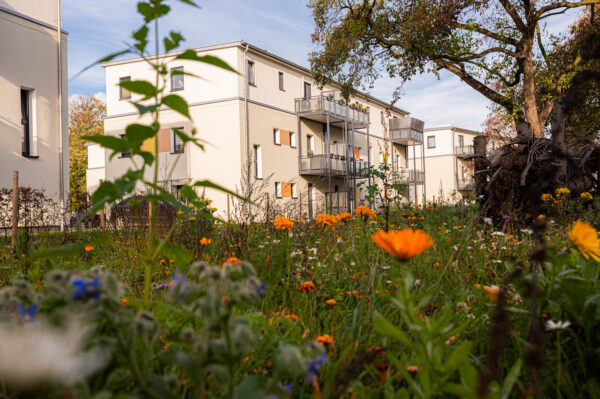Water, Effluents and Waste
GRI
303-5
306-1
306-2
Water Management
The increasing scarcity of water is becoming an increasingly important topic of discussion in Germany. Climate change is already making itself known in the form of longer periods of dry weather and more frequent heavy rain and storms. We expect that these incidents will increase in the future – and are applying our climate risk tool, which was developed further in the reporting year (see CO2 Reduction in the Housing Portfolio), to assess the risks more accurately. Although our portfolio has been relatively unaffected so far, we are preparing for the possible consequences. To this end, we are working on measures that will help to mitigate extreme weather conditions at a microclimate level or have the capacity to cool urban heat islands, such as greening the facades of buildings or installing roof trenches. We need an innovative approach to water management that will be able to handle the challenges of the future. There is significant potential in local rainwater seepage systems (based on retention basins and green roofs, for example) and using rainwater to water gardens. This potential also applies to ancillary costs. Our water management pursues the aims of lowering water consumption and using local rain and gray water.
Our standard processes contain numerous measures to minimize risk and damage. These include soil and flood surveys, which will allow us to draw up more effective water management plans for our neighborhoods. Water management is an integral part of all of our planned refurbishment and neighborhood development work. We have taken the “Rain management” planning topic into account in almost 30% of our 18 currently ongoing neighborhood developments.
Typical water management measures in the neighborhoods include the use of retention basins and areas, green roofs and facades, and drainage systems. Water from the roof drainage systems no longer runs into the public sewage system, but is collected and increasingly used for irrigation directly in the neighborhood. The increased use of seepage paving on paths and parking lots also contributes to lowering the extent to which our land is sealed and creates more space for natural ground drainage.
Our influence over the water consumption of our tenants is limited. The tenants themselves play the most important role when it comes to reducing water consumption. In addition to providing tenants with information, such as through our customer magazine “zuhause,” which is published three times a year, we also install water-saving components during modernization and refurbishment work, for example in toilets and taps. Regular functional checks and viewings in the buildings are also an opportunity to notice water leaks early on.
We use water-saving sanitary systems in our offices to reduce water consumption. We provide drinking water systems for the roughly 1,000 employees who work at the corporate headquarters in Bochum to reduce their use of plastic. We were able to significantly reduce water consumption by relocating our customer service site from Duisburg to a new property in Essen.
Waste Management
Waste separation concepts for good waste management and the promotion of recycling play a particularly important role in our construction and refurbishment work because they enable us to reuse valuable resources like windows. They are also becoming increasingly relevant for waste management purposes in our neighborhoods. During the year under review, we expanded our use of sustainable recycling schemes in our neighborhoods. We launched a pilot project in a neighborhood in Essen to investigates ways in which we can recycle green waste and separate household waste. Our findings will be rolled out to other neighborhoods in the future. We separate the waste produced in offices and common areas and do not use disposable items in the cafeteria. In Sweden we involve our tenants in the subject of waste separation and tell them about the opportunities that exist in the area of waste separation and prevention. This is one of the ways in which we plan to significantly reduce the amount of waste in Sweden – by 30% by 2030.
By means of careful documentation and monitoring of the work carried out on the construction sites by qualified staff and health and safety officers, we always strive to ensure that (contaminated) materials are disposed of correctly and lawfully. We provide Vonovia technicians with training on how to dispose of materials correctly.
There is also potential in how we manage our green spaces. We recycle horticultural waste for energy production in biomass power plants, compost green waste and use leftover wood offcuts as lumber. We are making use of these opportunities by developing new and sustainable schemes for recycling and reusing materials.


